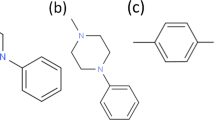Summary
-
1.
An in vitro vascularly and luminally perfused preparation of the murine small intestine was used to investigate the interference of isethionate, cyclamate and HEPES (N-2-hydroxyethylpiperazine-N′-2-ethanesulfonic acid) with the luminal transport of the isoprenaline-sulfoconjugate as well as with the basolateral transport of naphthol-sulfoconjugate.
-
2.
The sulfonates and sulfamates when administered from the luminal as well as from the contraluminal side of the epithelium inhibited the transport of isoprenaline-sulfoconjugate. Inhibition of the naphthol-sulfoconjugate transport across the contraluminal epithelial membrane was less pronounced, but a countertransport phenomenon could be induced with cyclamate in the vascular medium.
-
3.
The presence of phosphate at the luminal side is essential for the transport of the isoprenaline-sulfoconjugate across the luminal membrane. This is not the case for bicarbonate.
-
4.
The conclusion is drawn that different transport systems for sulfoconjugates exist in the luminal and in the contraluminal membranes of the intestinal mucosa, which can be inhibited by structurally related compounds. The luminal transport system can be activated from the luminal side by phosphate.
Similar content being viewed by others
References
Anderson RJ, Weinshilboum RM (1979) Phenolsulphotransferase: Enzyme activity and endogenous inhibitors in the human erythrocyte. J Lab Clin Med 94:158–171
Davis GR, Zerwekh JE, Parker TF, Krejs GJ, Pak CYC, Fordtran JS (1983) Absorption of phosphate in the jejungum of patients with chronic renal failure before and after correction of vitamin D deficiency. Gastroenterology 85:908–916
Eibl H, Lands WEM (1969) A new, sensitive determination of phosphate. Anal Biochem 30:51–57
Hartiala KJK (1973) Metabolism of foreign substances in the gastrointestinal tract. Handb Physiol 23:375–388
Hoensch H, Woo CH, Schmid R (1975) Cytochrome P-450 and drug metabolism in intestinal villous and crypt cells of rats: effect of dietary iron. Biochem Biophys Res Commun 65:399–405
Kabakoff B, Kendrick NC, DeLuca HF (1982) 1,25-Dihydroxy-vitamin D3-stimulated active uptake of phosphate by rat jejunum. Am J Physiol 343:E470-E475
Koster AS, Noordhoek J (1983) Glucuronidation in isolated perfused rat intestinal segments after mucosal and serosal administration of 1-naphthol. J Pharmacol Exp Ther 226:533–538
Lauterbach F (1977) Intestinal secretion of organic anions and drugs. In: Kramer M, Lauterbach F (eds) Intestinal permeation. Excerpta Medica, Amsterdam-Oxford, pp 173–194
Liedtke CM, Hopfer U (1977) Anion transport in brush border membranes isolated from rat small intestine. Biochem Biophys Res Commun 76:579–585
Pekas JC (1974) Naphthol metabolism: glucuronide conjugation and transport by the rat intestine in vitro. Toxicol Appl Pharmacol 29:404–419
Peterlik M, Fuchs R, Sing Cross H (1981) Phosphate transport in the intestine: cellular pathways and hormonal regulation. In: Bronner F, Peterlik M (eds) Calcium and phosphate transport across biomembranes. Academic Press Inc, New York, pp 173–189
Rennick BR, Quebbeman AJ (1971) Renal tubular excretion of drugs: proximal tubule secretion and metabolism. In: Fisher JW, Cafruny EJ (eds) Renal pharmacology. Butterworths, London, pp 67–84
Schwenk M, Frank B, Bolt H, Winne D (1981) Intestinal first pass effect of estrone sulfate and estrone in the rat. Drug Res 31:1254–1257
Schwenk M, Schiemenz C, Lopez del Pino V, Remmer H (1982) First pass biotransformation of ethinylestradiol in rat small intestine in situ. Naunyn-Schmiedeberg's Arch Pharmacol 321:223–225
Tiribelli C, Lunazzi G, Luciani M, Panfili E, Gazzin B, Liut G, Sandri G, Sottocasa G (1978) Isolation of a sulfobromophthalein-binding protein from hepatocyte plasma membrane. Biochim Biophys Acta 532:105–112
Ussing HH (1949) Transport of ions across cellular membrane. Physiol Revs 29:127–155
Weber E (1980) Grundriß der biologischen Statistik. Gustav-Fischer, Jena pp 242–263
Wigler PW (1981) Trans Effects in cell membrane transport. J Theor Biol 93:997–1008
Wilbrand W (1975) Biomembranes 7:11
Wollenberg P, Rummel W (1984) Vectorial release of sulfoconjugates in the vascularly perfused mouse small intestine. Biochem Pharmacol 33:205–208
Wollenberg P, Ullrich V, Rummel W (1983) Conjugation of 1-naphthol and transport of 1-naphthol-conjugates in the vascularly perfused small intestine of the mouse. Biochem Pharmacol 32:2103–2107
Author information
Authors and Affiliations
Rights and permissions
About this article
Cite this article
Wollenberg, P., Rummel, W. Influence of phosphate, sulfonic, and sulfamic acids on sulfoconjugate release in the vascularly perfused mouse small intestine. Naunyn-Schmiedeberg's Arch. Pharmacol. 329, 195–200 (1985). https://doi.org/10.1007/BF00501212
Received:
Accepted:
Issue Date:
DOI: https://doi.org/10.1007/BF00501212




